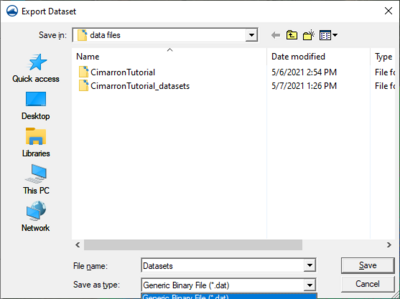SMS:Export Dataset Dialog: Difference between revisions
From XMS Wiki
Jump to navigationJump to search
(New page: The Export Data Set dialog is used to export scalar or vector data sets. To open the Export Data Set dialog, use the data set right click menu. ...) |
No edit summary |
||
| (28 intermediate revisions by 2 users not shown) | |||
| Line 1: | Line 1: | ||
The Export | [[Image:SMS Export dataset.png|thumb|400 px|''Export Dataset'' dialog]] | ||
The ''Export Dataset'' dialog is used to export scalar or vector datasets. To open the ''Export Dataset'' dialog, right-click on a dataset in the Project Explorer and select the [[SMS:Project Explorer Right-Click Menus|'''Export''']] command. | |||
* File Type | * File Type | ||
** Binary | ** Binary Dataset Files (*.dat) – Benefits include fast read/write times, small file size. | ||
** ASCII | ** ASCII Dataset Files (*.dat) – Can be imported into Microsoft Excel and viewed with standard text editors. Contains a single column of values | ||
** | ** XMDF Dataset Files (*.h5) – Benefits include fast read/write times, small file size, native compression. | ||
<!-- | |||
* Time Steps | |||
** Current time step – Exported dataset will only contain the current time step. | |||
** All time steps – Exported dataset will contain all time steps. | |||
--> | |||
* Filename – Path and filename used for exported dataset. | |||
Note that all time steps will be exported with the data file. | |||
To export an XYZ table of a [[SMS:Datasets|dataset]] see the [[SMS:Export Tabular File|Export Tabular File]] page. | |||
== Related Topics == | == Related Topics == | ||
* [[SMS:Binary | * [[SMS:Binary Dataset Files *.dat|Binary Dataset Files (*.dat)]] | ||
* [[SMS:ASCII | * [[SMS:ASCII Dataset Files *.dat|ASCII Dataset Files (*.dat)]] | ||
* [[XMDF|XMDF Files]] | * [[XMDF|XMDF Files]] | ||
{{Template:Navbox SMS}} | |||
[[Category:SMS Dialogs|Export]] | |||
[[Category:SMS File Format Dialogs]] | |||
[[Category:Exporting Data|data]] | |||
Latest revision as of 21:44, 9 June 2022
The Export Dataset dialog is used to export scalar or vector datasets. To open the Export Dataset dialog, right-click on a dataset in the Project Explorer and select the Export command.
- File Type
- Binary Dataset Files (*.dat) – Benefits include fast read/write times, small file size.
- ASCII Dataset Files (*.dat) – Can be imported into Microsoft Excel and viewed with standard text editors. Contains a single column of values
- XMDF Dataset Files (*.h5) – Benefits include fast read/write times, small file size, native compression.
- Filename – Path and filename used for exported dataset.
Note that all time steps will be exported with the data file.
To export an XYZ table of a dataset see the Export Tabular File page.
Related Topics
SMS – Surface-water Modeling System | ||
|---|---|---|
| Modules: | 1D Grid • Cartesian Grid • Curvilinear Grid • GIS • Map • Mesh • Particle • Quadtree • Raster • Scatter • UGrid |  |
| General Models: | 3D Structure • FVCOM • Generic • PTM | |
| Coastal Models: | ADCIRC • BOUSS-2D • CGWAVE • CMS-Flow • CMS-Wave • GenCade • STWAVE • WAM | |
| Riverine/Estuarine Models: | AdH • HEC-RAS • HYDRO AS-2D • RMA2 • RMA4 • SRH-2D • TUFLOW • TUFLOW FV | |
| Aquaveo • SMS Tutorials • SMS Workflows | ||
